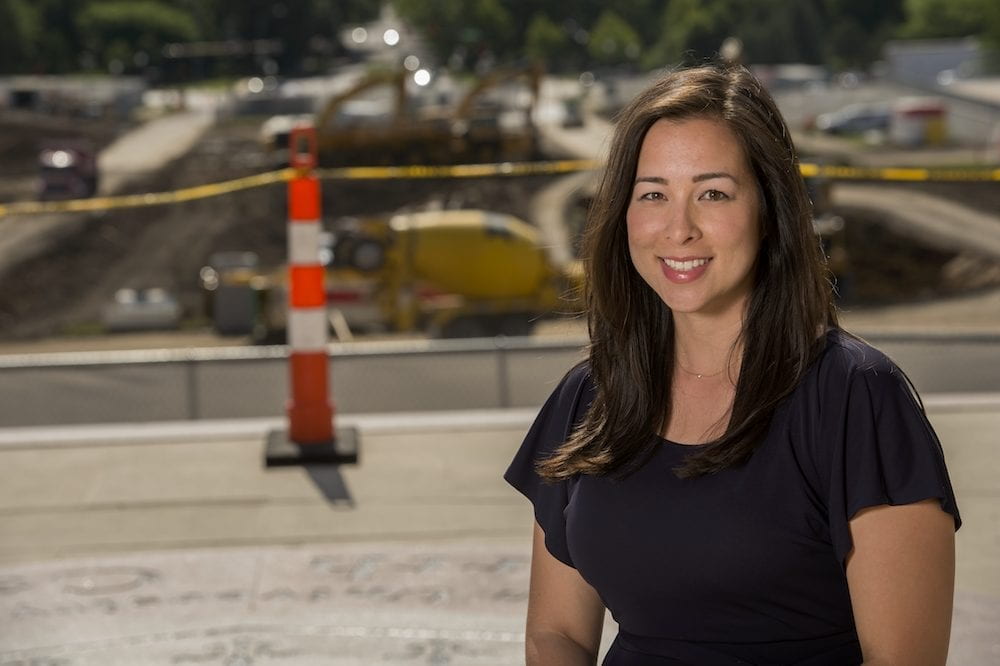
Washington University women are rolling up their sleeves and getting the job done on the East End construction site in a variety of ways, from engineering to project managing to communications. Here’s another in a series spotlighting women students, staff and alumni who are contributing to the transformation.
Jane Kojima, communications manager for the East End Transformation, tells us a little about herself and her new role.
Can you tell us about your professional background?
Before coming to WashU, I lived in New York City, working for organizations that improve the quality of life in NYC neighborhoods through community improvement and economic development. As deputy director of the Flatiron/23rd Street Partnership in Manhattan, I handled communications, which included developing free programming and events. Before Flatiron, I worked for the DUMBO Improvement District, which serves a neighborhood on the Brooklyn waterfront. The neighborhood has an artistic vibe: part of my role was to bridge the gap between creative people – artists, architects, and designers – and partners in real estate and government.
What inspires you?
Thoughtful design makes me tick – details that often go unnoticed or are so mundane they can be invisible. Details can take the functionality of something you use every day to another level; someone really thought about this and those details matter. In the design of public spaces, trash receptacles are an example. Subtle design modifications can make them more user-friendly, so people are less apt to litter, and also make it easier for those who service them. I’m fascinated by how these kinds of details are addressed to make cities more livable.
How did you come to do this kind of work?
I have a master’s degree in arts administration. During my studies, I became interested in how people interact with the urban environment. A course on urban development and the arts introduced me to pioneers like Jane Jacobs [an urbanist and activist who championed a fresh, community-based approach to city building] and Robert Moses [known as the “master builder” of mid-20th century New York City]. That changed the course of my career.
What interests you most about the East End Transformation?
The opportunity to be involved in large, meaningful, and impactful work. Projects like the East End Transformation are game changers. People are, understandably, unaware of how much planning and preparation take place behind the scenes and how many dedicated people are involved in making something like this happen – with the least inconvenience possible. Yet in the end, they can feel immediate ownership of the space, for their neighborhood or their community – like it’s always been there.
What about the project are you most excited about?
I’m excited about reclaiming car space and transforming it into people space. That so much real estate at the front door of the university is devoted to cars is an outdated concept and it’s not aesthetically pleasing or ideal for a pedestrian experience. Moving parking underground will bring back green, open space which was the original, intended vision for the east end of campus. It will improve the parking experience, with cars not baking in the hot sun during the summer or buried under ice and snow in the winter. Down the road, should demand for parking decline, the space can be adapted for other uses; it is an incredibly forward-thinking plan that puts people first.
What do you think your biggest challenge will be?
The perpetuation of misinformation will be a challenge. Today, the ease and speed at which information – factual or not – travels is incredible. We’ve put together a number of accessible channels for information about the East End to be both shared and received. The Campus Next website is a great starting place for a comprehensive history of this project, as well as info on other university capital projects. The new digital campus map shows up-to-date information on walkability and alternative modes of transportation like the West Campus shuttle and the circulator. Webcams capturing time-lapse photos of the construction site offer a bird’s eye view of progress. Feedback can be left through the suggestion box; I receive all communications submitted there and will be in touch if an item requires follow-up. There’s also a monthly e-newsletter. On Twitter, @WashUcampusnext is launching this month. We’ll be sharing updates, responding to questions, and offering behind-the-scenes looks at the project.
What can we expect during the construction process?
Undoubtedly, people’s routines will change in terms of getting around campus. We’re all creatures of habit and change is uncomfortable, but I really believe that in the end it will be worth it. The university has put a number of tools in place to mitigate the inconvenience. The Campus Next website can be used for reference and planning. Skype for Business can be used for video conferencing and instant messaging. Parking and Transportation Services has launched a golf cart escort system for students, faculty, staff, and visitors who have accessibility needs. And if there’s something we haven’t thought of drop me a line and share your idea. We’re all in this together!
If you’d like to make a suggestion, leave a comment, or just say hi to Jane, go to the East End Suggestion Box at Campus Next.
